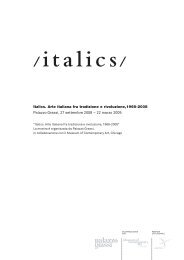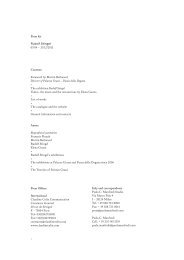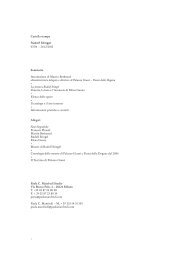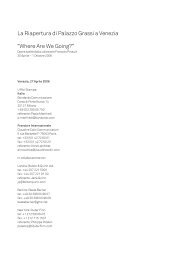pdf file, 819 Kb - Palazzo Grassi
pdf file, 819 Kb - Palazzo Grassi
pdf file, 819 Kb - Palazzo Grassi
Create successful ePaper yourself
Turn your PDF publications into a flip-book with our unique Google optimized e-Paper software.
4/<br />
Rome and the Barbarians, one thousand years of European history,<br />
by Yann Rivière, Director of Studies of the Ecole française de Rome<br />
« Pax Romana » without the Germanic peoples<br />
It is at the time of the conquest of the Gauls by Julius Caesar that the Roman troops crossed the Rhine for the<br />
first time and came into contact with the Germanic tribes, “violent and coarse men”, in the eyes of this general<br />
who outlined the first ethnographic portrait of the “barbarians”. A few decades later, emperor Augustus, founder<br />
of the principate, tried to pacify the territories on the right bank of the Danube and conquer those lying between<br />
the Rhine and the Elbe. At the end of his reign, the massacre of the legions of general and consul Quintilius<br />
Varus by Germanic tribes in the battle of the Teutoburg Forest, in 9 AD put an end to the Roman ambition to<br />
extend the empire to include this continental area.<br />
During a century and a half of “Pax Romana”, the Empire expanded northward: Emperor Claudius (41-54 AD)<br />
conquered Britain, and Trajan (98-117) created the only province located on the left bank of the Danube, Dacia<br />
(present-day Romania). At the same time (in 98 AD), the historian Tacitus first introduced his contemporaries<br />
to “these other peoples”, in his work Germania. The borders (the limes ) were consolidated everywhere. Starting<br />
from Domitianus (81-96 AD), the effort was concentrated in particular on the protection of the “Agri decumates”,<br />
a highly fortified area of the Empire that lay between the upper Rhine and the Danube. Emperors Hadrian<br />
(117-138 AD) and Antoninus (138-161 AD) also pushed back in the North of England the border of the Roman<br />
province of Britannia with the construction of an elaborate system of defence lines. The consolidation effort<br />
continued in Africa (modern Maghreb) until the reign of Severus (193-235 AD), in order to gain control of the<br />
Moorish populations as far as the edges of the desert. In mid-2nd century, the orator Aelius Aristides could sing<br />
the praise of the civilizing work of an empire centered in the Mediterranean, able to pacify and integrate the<br />
most diverse peoples. At the time it was not allowed to cast doubts on Roman power. “That is why”, he exclaims<br />
in is panegyric on Rome, “in seeing the drive and the organization of the military force, one will think, in accordance<br />
with the Homeric expression, that, were the enemies ten times as many, they would quickly be driven back<br />
and overcome to the last man”.<br />
However, some time later, the Empire was shaken by a double attack, from the Parthians in the East, and<br />
from the Germanic tribes on the Danube. The river was crossed and the Italian soil overrun by the barbarians.<br />
Throughout his reign, emperor Marcus Aurelius (161-180 AD) endeavoured to redress a situation that reflected<br />
the limits of the defence system set up one century and a half earlier. These military circumstances, worsened<br />
by the plague, marked an epochal change, which is expressed through art: one such example is the violence of<br />
the scenes spiralling around the shaft of the column of Marcus Aurelius or the tangle of bodies and faces on<br />
the Portonaccio battle sarcophagus: “ exhausted men, emaciated, scarred by sorrow and humiliation, born of a<br />
new conscience of the fragility of the human being” (B Andreae). And it is at the close of the 2nd century that the<br />
civilization of late Antiquity finds its origin.<br />
From the Third Century Crisis to the Tetrarchs<br />
From then on, warring in the Danube area became constant, while in the East, the Parthian threat was replaced<br />
by the Persian Empire pressing at the borders. In the 230s, the Roman Empire entered “the Third Century Crisis”:<br />
emperor Decius, who fought against the Goths in 251, died while fighting; ten emperors were killed by their<br />
troops; it was necessary to accept “ignominious” peace treaties, such as the one with the Goths in 253; provincial<br />
territories were definitively abandoned (the “Agri Decumates” under Gallienus, Dacia under Aurelian),<br />
others temporarily broke away from Rome to ensure their own defence (“the Gallic Empire” from 258 to 268);<br />
the Danubian provinces were devastated by the Goths, who put Athens under siege in 268; the Alamanni penetrated<br />
into Gaul in 259, then again in 275, at the same time as the Franks. On three occasions the emperors<br />
had to defend the Italian soil: Gallienus in 259 and Claudius II Gothicus in 269 against the Alamanni; Aurelian in<br />
270 against the Vandals. At this point Rome, which had not been besieged since 390 BC, had to be surrounded<br />
by protective walls.<br />
Starting from the mid-3rd century, however, reforms were introduced in order to increase the mobility of the<br />
army and improve the effectiveness of its organization. At the same time, recruitment was opened also to barbarians,<br />
who found in the army a way of entering into the service of the Empire and at the same time prove their<br />
military prowess and ensure a living to their families: “ A Frank in the civilian world, I am a Roman soldier under<br />
arms”, reads a funerary inscription of the following century. From the late 260s, the situation began to stabilize
















